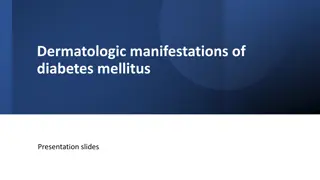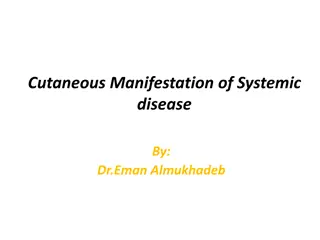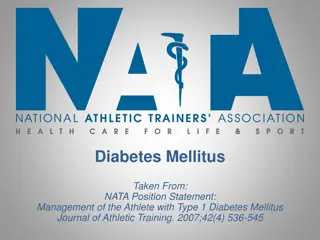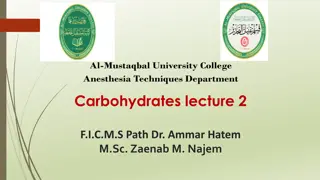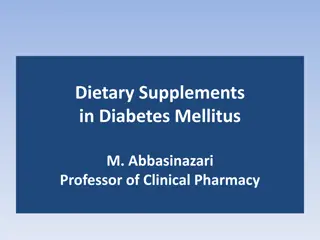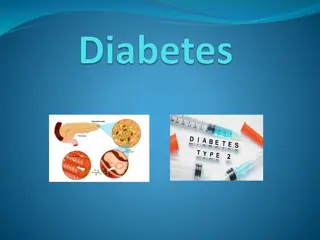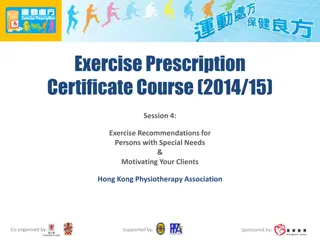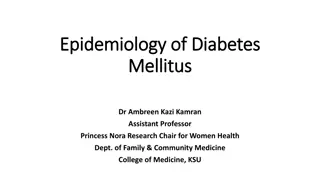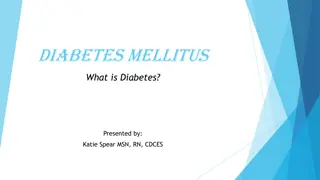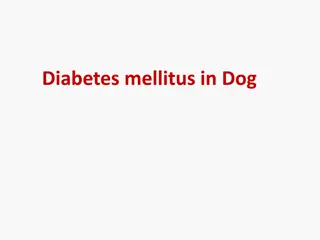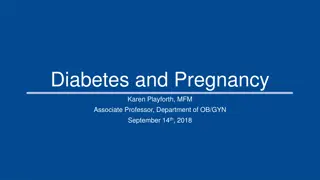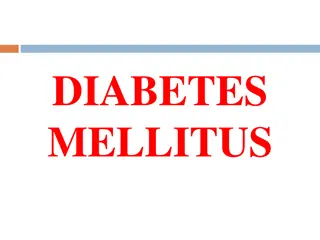Diabetes Mellitus
Diabetes Mellitus is a chronic endocrine disorder characterized by hyperglycemia, impaired insulin secretion, and insulin resistance. This article explores the differences between Type 1 and Type 2 DM, highlighting factors such as islet cell antibodies, genetic links, age of onset, symptom onset, treatment approaches, and complications. Additionally, it delves into the pathophysiology of Type 1 DM, focusing on acute insulin deficiency, hepatic glycogenolysis, gluconeogenesis, and counter-regulatory hormone responses.
Download Presentation

Please find below an Image/Link to download the presentation.
The content on the website is provided AS IS for your information and personal use only. It may not be sold, licensed, or shared on other websites without obtaining consent from the author.If you encounter any issues during the download, it is possible that the publisher has removed the file from their server.
You are allowed to download the files provided on this website for personal or commercial use, subject to the condition that they are used lawfully. All files are the property of their respective owners.
The content on the website is provided AS IS for your information and personal use only. It may not be sold, licensed, or shared on other websites without obtaining consent from the author.
E N D
Presentation Transcript
Diabetes Mellitus Chronic condition Chronic condition Endocrine Disorder Endocrine Disorder Hyperglycemia Hyperglycemia Impaired insulin secretion Impaired insulin secretion Insulin resistance Insulin resistance
Differences between type Differences between type 1 1 and type and type 2 2 DM DM Type - -cell Islet cell antibodies Strong genetic Age of onset usually below Faster onset of symptoms Patients Insulin must be administered Extreme ketoacidosis Type 1 1 diabetes cell destruction Islet cell antibodies present Strong genetic link Age of onset usually below 30 Faster onset of symptoms Patients usually not Insulin must be administered Extreme hyperglycaemia ketoacidosis diabetes destruction Type No No islet cell antibodies present Very strong genetic link Age of onset usually above Slower onset of symptoms Patients Diet control and oral agent Extreme hyperglycaemic Type 2 2 diabetes No - -cell No islet cell antibodies present Very strong genetic link Age of onset usually above 40 Slower onset of symptoms Patients usually Diet control and oral hypoglycaemic agent Extreme hyperglycaemia hyperglycaemic state diabetes cell destruction destruction present link 30 40 usually not overweight overweight usually overweight overweight hypoglycaemic glycemic glycemic hyperglycaemia causes causes diabetic diabetic hyperglycaemia causes hyperosmolar state causes hyperosmolar
Type Type 1 1 DM DM Genetic (1 2%) and Environmental factors Circulating islet cell antibodies (ICAs) Precedes the onset of clinical diabetes by as much as 3 years. The final event that precipitates clinical diabetes may be caused by sudden stress, infection when the mass of -cells in the pancreas falls below 5 10%.
Type Type 1 1 DM / Pathophysiology DM / Pathophysiology Acute deficiency Hepatic Acute deficiency of Hepatic glycogenolysis of insulin that glycogenolysis, , insulin that leads leads to: to: Gluconeogenesis, Gluconeogenesis, Hepatic glucose output Hepatic glucose output, , Glucose uptake by insulin Glucose uptake by insulin- -sensitive tissues sensitive tissues sudden cortisol sudden stress, cortisol, catecholamine and growth stress, infection , catecholamine and growth hormone) infection--- --- counter counter- -regulatory hormones (glucagon, hormone) regulatory hormones (glucagon, increase hepatic glucose. increase hepatic glucose.
Type Type 2 2 DM DM Strong genetic predisposition (5 10%) Insulin resistance and -cell dysfunction 85% of people with type 2 diabetes are obese
Type Type 2 2 DM / Pathophysiology DM / Pathophysiology Less acute Hyperinsulinaemia time, but eventually ensues. Routin glucose or develops At the time lost Less acute --- Hyperinsulinaemia is able to maintain glucose levels for time, but eventually - -cell function deteriorates ensues. Routin check glucose or hyperinsulinaemia develops. . At the time of diagnosis, those with type lost about --- Insulin production is able to maintain glucose levels for a period cell function deteriorates and Insulin production decreases over a sustained decreases over a sustained period. period. a period of hyperglycaemia of and hyperglycaemia check for Impaired glucose tolerance (IGT), hyperinsulinaemia may be detected for Impaired glucose tolerance (IGT), Impaired fasting may be detected before overt Impaired fasting before overt diabetes diabetes of diagnosis, those with type 2 2 diabetes may have about 50 diabetes may have already already 50% of their % of their - -cell function. cell function.
Pathophysiology of insulin resistance Pathophysiology of insulin resistance Abdominal fat is resistant to the antilipolytic effects of insulin release of excessive amounts of free fatty acids resistance in the liver and muscle in the liver and an inhibition of insulin-mediated glucose uptake in the muscle. insulin increase in gluconeogenesis Excess fat additional fat causing insulin resistance in these organs. adipocytes become too large fat storage in the muscles, liver and pancreas, unable to store
Pathophysiology of insulin resistance Pathophysiology of insulin resistance Adipose tissue causes the of some cytokines: plasminogen activator inhibitor-1 (which is prothrombotic), tumour necrosis factor- and interleukin-6 (which are proinflammatory) resistin (which causes insulin resistance). Excess adipose tissue beneficial adipokine (adiponectin). Adiponectin suppresses the attachment of monocytes to endothelial cells, thereby protecting against vascular damage.
Clinical manifestations Clinical manifestations Polyuria (increased Polydipsia ( Osmotic diuresis Fatigue due because of the energy Blurred Higher infection due to increased urinary glucose levels. Polyuria (increased urine production, particularly noticeable at night) Polydipsia (increased thirst). Osmotic diuresis secondary to Fatigue due to an because of the breakdown of energy source to Blurred vision caused by a change in lens Higher infection rate, especially Candida, and urinary due to increased urinary glucose levels. urine production, particularly noticeable at night) increased thirst). secondary to hyperglycaemia to an inability to breakdown of body protein and fat as an alternative source to glucose. vision caused by a change in lens refraction rate, especially Candida, and urinary tract infections hyperglycaemia. . utilise glucose and marked weight loss body protein and fat as an alternative inability to utilise glucose and marked weight loss glucose. refraction tract infections
Diagnosis Diagnosis With symptoms plus: Fasting serum glucose concentration 7.0 mmol/L or serum glucose concentration 11.1 mmol/L 2 h after 75 g anhydrous glucose in an OGTT. With symptoms (polyuria plus: (polyuria, polydipsia , polydipsia and unexplained and unexplained weight loss) weight loss) With no Diagnosis should not be based on a single glucose determination. With no symptoms symptoms, Glycated Glycated haemoglobin haemoglobin (HbA (HbA1 1c c) )
Symptoms of Symptoms of Hypoglycaemia Hypoglycaemia + (table + (table 44.4 44.4) ) Autonomic Sweating Trembling Tachycardia Palpitations Pallor Other Hunger/ Headache Perioral tingling/numbness Autonomic Sweating Trembling Tachycardia Palpitations Pallor Other Hunger/ Headache Perioral tingling/numbness Neuroglycopaenic Faintness Loss of concentration Drowsiness Visual disturbances Abnormal behaviour (agitation, aggressiveness) Confusion and Coma Neuroglycopaenic
Diabetic ketoacidosis Blood glucose level > 22 mmol/L
Hyperglycaemia Lowers serum volume Osmotic diuresis Ketones Hyperosmolarity Anorexia, nausea and vomiting Stimulation of the vomiting center Potassium loss
Hyperosmolar Hyperosmolar hyperglycemic hyperglycemic state state No significant ketone No significant ketone production and therefore no severe acidosis production and therefore no severe acidosis. . Hyperglycemia increase blood viscosity Hyperglycemia osmotic increase blood viscosity and the risk of thromboembolism osmotic diuresis and the risk of thromboembolism. . diuresis dehydration dehydration hyperosmolarity hyperosmolarity Factors precipitating HHS adherence with impair Factors precipitating HHS are infection, myocardial infarction, poor adherence with medication regimens or medicines which cause diuresis impair glucose tolerance, for example, glucocorticoids. are infection, myocardial infarction, poor medication regimens or medicines which cause diuresis or glucose tolerance, for example, glucocorticoids. or
Long Long- -term diabetic complications term diabetic complications Macrovascular disease Cardiovascular Peripheral vascular disease Microvascular disease Retinopathy Nephropathy Peripheral neuropathy Cardiovascular disease Peripheral vascular disease disease Retinopathy Nephropathy Peripheral neuropathy
Cardiovascular Cardiovascular disease disease The most common cause of death in people with type The most common cause of death in people with type 2 2 diabetes diabetes Silent myocardial infarction (infarction with common in those with Silent myocardial infarction (infarction with no symptoms common in those with diabetes no symptoms) is more ) is more diabetes Cerebrovascular disease Cerebrovascular disease is also more commonly associated with is also more commonly associated with diabetes diabetes Hypertension is twice as common over Hypertension is twice as common amongst the over 80 amongst the diabetic diabetes diabetic population. It population. It affects affects 80% of those with type % of those with type 2 2 diabetes
Peripheral vascular Peripheral vascular disease disease PVD affects the blood vessels outside the heart It often affects the arteries of the legs A cramping pain experienced on walking, due to reversible muscle ischaemia secondary to atherosclerosis.
Retinopathy Retinopathy The main problem with until The main problem with retinopathy until the retinopathy is is that it that it is is symptomless symptomless the disease is far advanced disease is far advanced. . Tight the Tight glycaemic the progression of retinopathy in patients glycaemic control has been shown to prevent and progression of retinopathy in patients with DM. control has been shown to prevent and delay delay with DM.
Nephropathy Nephropathy In diabetic renal disease, the kidneys become enlarged the In diabetic renal disease, the kidneys become enlarged and the glomerular filtration rate (GFR) initially increases and glomerular filtration rate (GFR) initially increases. . Detection by GFR estimation and (ACE) inhibitors and/or (ARBs) are the treatments of choice, provide renal protective effects. Detection by GFR estimation and microalbuminuria (ACE) inhibitors and/or (ARBs) are the treatments of choice, provide renal protective effects. microalbuminuria
Peripheral Peripheral neuropathy neuropathy progressive loss of dysfunction progressive loss of peripheral nerve dysfunction. . peripheral nerve fibres fibres resulting in nerve resulting in nerve sensory, motor sensory, motor and autonomic and autonomic symptoms. symptoms.
Macro Macro- - and microvascular disease combined and microvascular disease combined Foot problems often develop as a result of a combination of specific problems associated with having diabetes, that is sensory and autonomic neuropathy, PVD and hyperglycaemia.
There are three main types of foot ulcers: There are three main types of foot ulcers: Neuropathic loss of pain sensation Ischaemic a reduction in available healing Ischaemic of the toes. Most ulcers have are termed Neuropathic ulcers occur loss of pain sensation. . Ischaemic ulcers result from PVD a reduction in available nutrients and healing. . Ischaemic ulcers are of the toes. Most ulcers have elements of both neuropathy and are termed neuroischaemic ulcers occur when peripheral when peripheral neuropathy causes neuropathy causes ulcers result from PVD and poor nutrients and oxygen required for and poor blood supply causing oxygen required for blood supply causing ulcers are painful and painful and usually occur on the distal ends usually occur on the distal ends elements of both neuropathy and ischaemia neuroischaemic. . ischaemia and and
Charcot Charcot arthropathy arthropathy This is an uncommon foot complication caused by severe neuropathy. It results in chronic, progressive destruction of joints with marked inflammation. Reduced bone density leads to bone fractures, altered foot shape and gross deformity
Charcot Charcot arthropathy arthropathy This is an uncommon foot complication caused by severe neuropathy. It results in chronic, progressive destruction of joints with marked inflammation. Reduced bone density leads to bone fractures, altered foot shape and gross deformity
Thiazolidinedi one Bind to the PPAR and regulate the expression of multiple genes Biguanides Inhibit gluconeogenesis and increased insulin-stimulated glucose uptake Sulfonylureas Stimulate insulin release from the - cells of the pancreas Dipeptidyl pepidase-4 inhibitors Alpha- Glucosidase Inhibitors Inhibit the digestion of complex carbohydrates Incretin Mimetics bind to GLP-1 receptors and stimulate glucose dependent insulin release. Meglitinides Stimulate insulin release from the -cells of the pancreas



